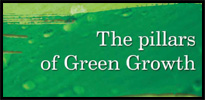Argentina: Argentina Environment Profile 2012
2012/02/15
Argentina Environment Profile 2012
 A main environmental trouble in Argentina is pollution, particularly water pollution in urban areas due to damaging disposal practices and in rural areas where rivers are polluted by growing use of pesticides and fertilizers. The soy explosion reinforced this tendency. 20% of urban inhabitants and 83% of people living in the countryside do not have access to running water.
A main environmental trouble in Argentina is pollution, particularly water pollution in urban areas due to damaging disposal practices and in rural areas where rivers are polluted by growing use of pesticides and fertilizers. The soy explosion reinforced this tendency. 20% of urban inhabitants and 83% of people living in the countryside do not have access to running water.
Supplementary threats to the environment are the overexploitation of huge mineral resources, erosion problems due to inadequate flood controls and unsuitable land use practices, the hole in the ozone layer above Patagonia and the South Pole, and the worsening of irrigated areas and desertification. Though the goal of sustainable development was incorporated in Article 41 of the 1994 constitution as the “polluter pays” principle, environmentally compatible growth receives only sporadic consideration and has a weak institutional framework. Theoretically, the budget surplus provides room to maneuver for environment protection. However, the government’s engagement remains modest and there is still no successful cooperation between the different levels of government in this area.
Macroeconomic growth is uneven and only partially takes environmental concerns into consideration. Sustainability lacks strong institutional foundations, and short-term growth objectives have taken precedence over sustainability considerations. Public environmental consciousness is still weak, and punitive measures for infringements are more an exception than the rule. Finally, the country has still not formed a national environmental policy, and existing environmental laws are often not compulsory because of a lack of adequate control mechanisms. On the positive side, in a large success for environmental and social groups, each province had to produce a plan over the course of 2008 designating all forests within three categories: red, amber and green to signify the degree to which they are endangered. This plan met with fierce opposition from legislators from the northern provinces.
 In January, February and March 2008, Argentina’s key agricultural provinces – Buenos Aires, Córdoba, Santa Fe, Entre Rios, Santiago de Estero and La Pampa – suffered the worst drought in some 50 years. As a result, crop yields were down by more than 40% in some areas and livestock losses exceeded half a million. The government was forced to declare a state of agricultural emergency, but farmers argue – not unreasonably – that the government’s aid measures do not go nearly far enough. In the long term, the costs of the drought, to both the country’s finances and the government, are likely to be high.
In January, February and March 2008, Argentina’s key agricultural provinces – Buenos Aires, Córdoba, Santa Fe, Entre Rios, Santiago de Estero and La Pampa – suffered the worst drought in some 50 years. As a result, crop yields were down by more than 40% in some areas and livestock losses exceeded half a million. The government was forced to declare a state of agricultural emergency, but farmers argue – not unreasonably – that the government’s aid measures do not go nearly far enough. In the long term, the costs of the drought, to both the country’s finances and the government, are likely to be high.
- Argentina News
-
- ISRAEL: Netanyahu to pioneer new diplomatic grounds in Latin America
- ISRAEL: Netanyahu’s Historic Latin American Tour to Highlight Israeli Tech Sector
- ISRAEL: PM Netanyahu leaves on historic visit to Latin America
- AFGHANISTAN: UNWTO: International tourism – strongest half-year results since 2010
- ARGENTINA: ARGENTINA: Country To Resume Pork Imports From The United States
- ARGENTINA: $33.2 billion for transport infrastructure through 2019
- Trending Articles
-
- SOUTH AFRICA: Nigeria and South Africa emerge from recession
- BAHRAIN: Bahrain issues new rules to encourage fintech growth
- ARUBA: Director of Tourism Turks and Caicos after Irma: Tourism, visitors, hotels current status
- ANGOLA: Angola: Elections / 2017 - Provisional Data Point Out Qualified Majority for MPLA
- WORLD: How fair is our food? Big companies take reins on sourcing schemes
- NIGERIA: Nigeria has been one of the hardest-hit economies due to its over-dependence on oil










